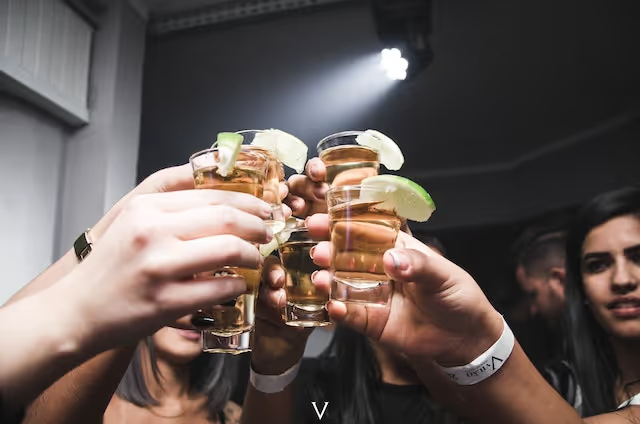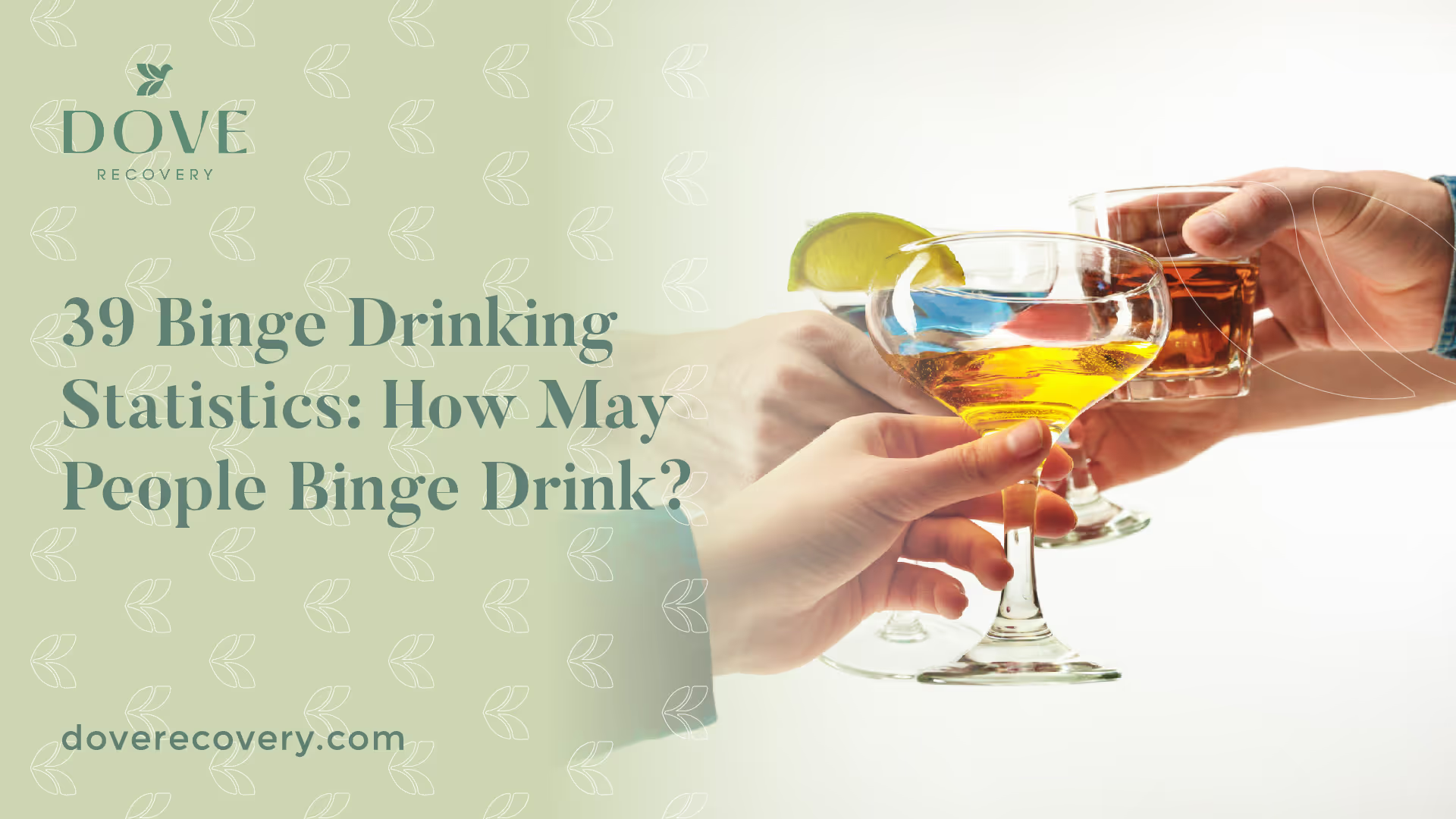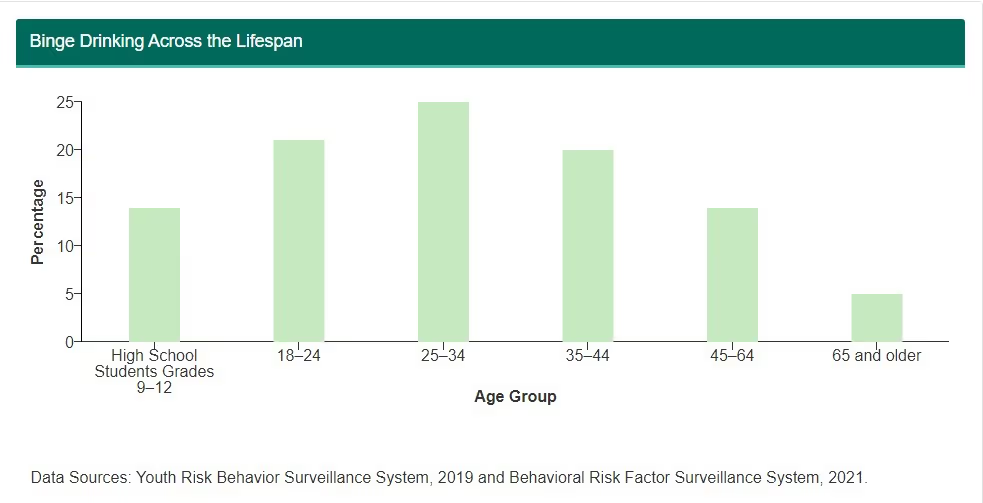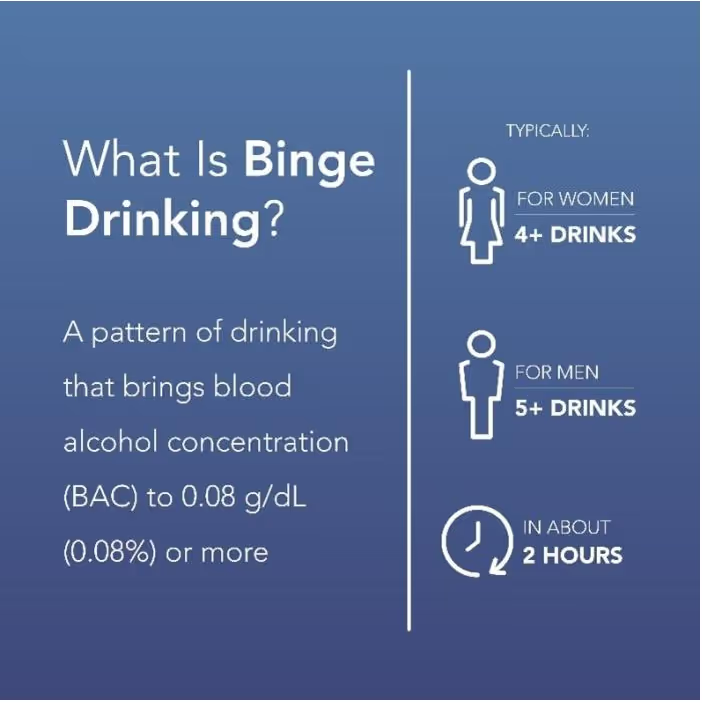39 Binge Drinking Statistics: How May People Binge Drink?


Wondering How Many People Binge Drink?
Binge drinking is a pattern of drinking alcohol that brings blood alcohol concentration (BAC) levels to 0.08 g/dL or higher. This typically occurs after a woman consumes 4 drinks or a man consumes 5 drinks in about 2 hours. According to the National Institute on Alcohol Abuse and Alcoholism (NIAAA), binge drinking is a widespread problem in the United States, with serious health and social consequences.
Key Binge Drinking Statistics:
- In 2019, 24.5% of people aged 18 or older reported that they engaged in binge drinking in the past month. This means that 1 in 4 adults engaged in this behavior, according to the NIAAA.
- Binge drinking is more common among young adults aged 18-34. In fact, 32.1% of adults in this age group reported binge drinking in the past month, compared to 22.2% of adults aged 35 or older.
- Men are more likely than women to engage in binge drinking. In 2019, 29.3% of men reported binge drinking in the past month, compared to 19.2% of women.
- Binge drinking is more common among people who have higher levels of education and income. For example, 28.2% of people with a household income of $75,000 or more reported binge drinking in the past month, compared to 19.5% of people with a household income of less than $25,000.
- Binge drinking is responsible for more than half of the 88,000 alcohol-attributable deaths in the United States each year, according to the Centers for Disease Control and Prevention (CDC).
- Binge drinking can lead to a wide range of health problems, including liver disease, high blood pressure, stroke, and certain types of cancer. It can also increase the risk of unintentional injuries, such as car crashes and falls.
- Binge drinking can also have serious social consequences, such as relationship problems, legal issues, and financial problems.
It's clear that binge drinking is a serious problem in the United States, with far-reaching consequences for individuals, families, and communities. If you or someone you know is struggling with binge drinking, it's important to seek help from a healthcare provider or a substance abuse treatment program.
Who Binge Drinks?
Binge drinking is a widespread issue that affects people from all walks of life. However, research suggests that certain groups are more likely to engage in this behavior than others. For instance:
- Young adults aged 18-34 are more likely to binge drink than older adults.
- Men are more likely than women to engage in binge drinking.
- People with higher levels of education and income tend to engage in binge drinking more frequently than those with lower income and education levels.

These demographic factors are not the only ones that influence binge drinking behaviors. Social and cultural factors can also play a role, such as:
- Peer pressure and the desire to fit in with one's peers, which may be particularly relevant for college students.
- The view of heavy alcohol consumption as a sign of masculinity or social status in certain cultures.
It's worth noting that anyone can develop a problem with binge drinking, regardless of their age, gender, income level, or cultural background. If you or someone you know is struggling with this issue, seeking help from a healthcare provider or a substance abuse treatment program can make all the difference.
Binge Drinking Demographics
Binge drinking is a complex issue that affects people of all ages, genders, and socioeconomic backgrounds. However, certain demographic groups are more likely to engage in binge drinking behavior than others.
Studies have found that young adults aged 18-34 are the most likely to engage in binge drinking. This group has the highest prevalence of binge drinking compared to any other age group. Peer pressure, stress associated with college life, and a desire to fit in with peers may be some of the reasons why this group is more prone to binge drinking.
Men are also more likely than women to engage in binge drinking behavior. In fact, studies show that men consume twice as much alcohol as women when they do drink. This difference in gender-based alcohol consumption can be attributed to societal norms and expectations surrounding masculinity.

People with higher levels of education and income tend to engage in binge drinking more frequently than those with lower income and education levels. Some researchers believe that this may be due to greater disposable income and access to social events where alcohol is served.
Binge Drinking by Race
Binge drinking is a significant issue that can affect individuals of all races. However, research suggests that there are differences in binge drinking rates among different racial groups. According to the National Institute on Alcohol Abuse and Alcoholism (NIAAA), in 2019, White adults were more likely to engage in binge drinking than Black and Hispanic adults. Specifically, 25.8% of White adults reported binge drinking in the past month, compared to 19.5% of Black adults and 18.6% of Hispanic adults.
It's crucial to note that these statistics may not provide a complete picture of the issue. For instance, they do not consider variations within racial groups based on socioeconomic status or other factors that may influence drinking behaviors. Additionally, cultural attitudes towards alcohol consumption may differ among different racial and ethnic groups.
Despite these limitations, it's evident that binge drinking remains a problem that affects people from all racial backgrounds. For example:
- Native American communities have higher rates of binge drinking compared to other racial groups.
- Asian Americans have lower rates of binge drinking compared to other racial groups but may face unique cultural barriers to seeking help for alcohol-related problems.
To address this issue effectively, healthcare providers and policymakers must develop targeted interventions and education campaigns that consider the unique experiences and needs of different communities. By working together to raise awareness about the risks associated with binge drinking and providing resources for prevention and treatment, we can better support individuals and communities affected by this issue.
Underage Drinking Statistics
Underage drinking is a significant public health concern in the United States. According to the NIAAA, about 7.0 million young people aged 12-20 reported consuming alcohol in the past month. This represents approximately 19% of this age group, with 11% reporting binge drinking behavior.
The consequences of underage drinking can be severe and long-lasting. Adolescents who drink alcohol are more likely to experience academic problems, engage in risky sexual behavior, and have legal issues such as arrests for driving under the influence (DUI).

Moreover, underage drinking can lead to chronic health problems later on in life, such as addiction and liver disease. The CDC estimates that alcohol use among young people contributes to over 4,300 deaths each year due to car crashes, homicides, suicides and other accidents.
How Many Binge Drinks are Consumed?
Binge drinking is defined as reaching a blood alcohol concentration (BAC) level of 0.08 g/dL or higher, but the number of drinks it takes to reach this level can vary depending on several factors. For example, gender, weight, and tolerance can all affect how quickly alcohol is metabolized by the body.
On average, it takes about four drinks for women and five drinks for men to reach a BAC of 0.08 g/dL in about two hours. However, it's worth noting that some people may reach this level with fewer drinks, while others may require more. Moreover, individual factors such as genetics, medication use, and overall health status can also influence how alcohol affects a person.
Regardless of the number of drinks consumed, binge drinking can have serious health consequences. These can include alcohol poisoning, liver disease, high blood pressure, and an increased risk of accidents and injuries. It's crucial to be aware of the potential risks associated with binge drinking and to seek help from a healthcare provider or a substance abuse treatment program if needed.
Reasons for Binge Drinking
Binge drinking can have a variety of underlying causes. Some people may engage in this behavior as a way to cope with stress, anxiety, or depression. Others may do so to fit in with their peers or to feel more socially comfortable in certain situations. Still, others may simply enjoy the effects of alcohol and use binge drinking as a way to enhance their experience.
According to a survey conducted by the Substance Abuse and Mental Health Services Administration (SAMHSA), some of the most common reasons that young adults aged 18-25 reported binge drinking include:
- To have fun (62%)
- To celebrate special occasions (51%)
- To feel good or get high (50%)
- To relieve stress (38%)
- Because it's a part of their social life (28%)
It's worth noting that these are not the only reasons that people engage in binge drinking, and there can be many complex factors at play. However, understanding some of the most common motivations for this behavior can help healthcare providers and loved ones better support those who struggle with it.
Binge Drinking Costs
Here are some statistics that further illustrate the economic impact of binge drinking:
- In 2010, the total cost of excessive alcohol consumption in the United States was $249 billion.
- Of this total amount, $191 billion (77%) was attributed specifically to binge drinking.
- The highest per-person cost of excessive alcohol consumption was among those aged 35-44 years old ($2,746).
- Excessive alcohol consumption was responsible for approximately 1 in 10 deaths among working-age adults (aged 20-64 years) in the United States.
- The majority of economic costs related to binge drinking were due to lost productivity (72%).
Conclusion
Binge drinking is a serious public health issue in the United States that affects people of all ages, genders, and socioeconomic backgrounds.
It can lead to a wide range of health problems and social consequences, and it's responsible for thousands of deaths each year. While certain demographic groups may be more likely to engage in binge drinking behavior than others, anyone can develop a problem with alcohol.
It's crucial that we work together to raise awareness about the risks associated with binge drinking and provide resources for prevention and treatment. This includes developing targeted interventions and education campaigns that consider the unique experiences and needs of different communities. By addressing this issue head-on, we can better support individuals and families affected by binge drinking and reduce its impact on our society as a whole.
Sources:
- National Institute on Alcohol Abuse and Alcoholism. (2021). Binge Drinking. Retrieved from https://www.niaaa.nih.gov/alcohol-health/overview-alcohol-consumption/moderate-binge-drinking
- Substance Abuse and Mental Health Services Administration. (2020). Key Substance Use and Mental Health Indicators in the United States: Results from the 2019 National Survey on Drug Use and Health. Retrieved from https://www.samhsa.gov/data/sites/default/files/reports/rpt29393/2019NSDUHFFRPDFWHTML/2019NSDUHFFR1PDFW090120.pdf
- Centers for Disease Control and Prevention. (2021). Excessive Drinking is Draining the U.S. Economy. Retrieved from https://www.cdc.gov/features/costsofdrinking/index.html
